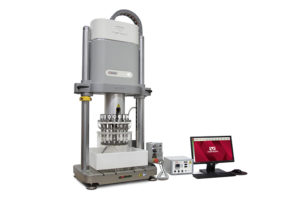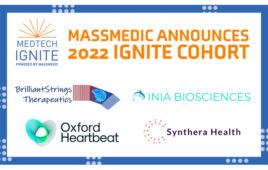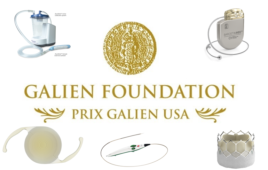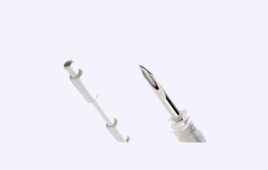Pulsatile durability testing is a time-consuming part of the vascular stent approval process. Accelerated test designs can deliver a high throughput when every specimen counts.
Pete Bailey, Instron

(Image courtesy of Instron)
There are many quality controls applied to the design and release of coronary and other vascular stent devices, but a proof test of pulsatile durability, such as those laid out in ASTM F2477-19 (i.e. fatigue in diametral distension), is probably one of the most unavoidably time-consuming.
This is a simple “test to success” methodology, but it ensures a clear benchmark result of pass/fail. The test must simulate the dilational loading of 10 years of service at 72 B.P.M., meaning that the device must survive 380 million cycles in saline or simulant fluid. To demonstrate statistical confidence that this is a guaranteed safe life, it is generally considered necessary to test a representative sample of 30 specimens, all of which must pass.
Ways to speed the process
There is a commercial imperative to accelerate this testing by higher frequency, so most workers aim to bring the test frequency up to at least 30Hz, as this reduces the test time to just under 5 months. With good quality equipment, it is often possible to increase that to as much as 50Hz, but higher frequencies tend to introduce unacceptable levels of uncertainty due to mechanical effects.
The fact remains that this is still a huge number of machine-hours, so further gains in throughput are usually made by use of a carousel fixture to automatically test multiple specimens in parallel. This approach has been in use for over a decade, with jigs holding 6 or 12 specimens, but the state of the art now offers carousels with 16 stations, each with individual adjustment, and fully synchronous individual measurements of force for all 16 specimens in parallel. This means that a full batch test can now be delivered reliably in under 5 months with 2 test machines.
It is important to emphasize that over the last decade, the industry has widely adopted a more extensive “fatigue to failure” approach, such as that described in ASTM F3211. Especially in the early design phase, this means that a smaller sample size may be permissible, but also that a range of different loadings must be applied, such that some specimens will fail much sooner. This approach demands a much more thorough understanding of the structural loading distributions within the device and is expected to be combined with detailed finite element analysis models, effectively providing physical validation of the theoretical model.
High standards apply
An over-arching view of the expected body of testing and evaluation work is given in FDA Guidance Document 1545 Non-Clinical Tests and Recommended Labeling for Intravascular Stents and Associated Delivery Systems (latest revision April 2010). Overall, there is a general expectation for the designer to demonstrate a rigorous understanding of both experimental and modeling data, from the component material response building up to the full device durability.
High-quality test equipment and fixtures play a crucial role for competitive players in this industry, so it is important to understand your needs and develop a reliable laboratory set up. If you are entering the field or expanding your capability, make the most of your relationship with test equipment manufacturers.
Pete Bailey is principal application specialist on fatigue and fracture testing at Instron Division of ITW. He has a doctorate in materials science and a has worked on experimental methods in research and development for various fields, usually with a focus on durability and time-dependent phenomena.
The opinions expressed in this blog post are the author’s only and do not necessarily reflect those of Medical Design and Outsourcing or its employees.




